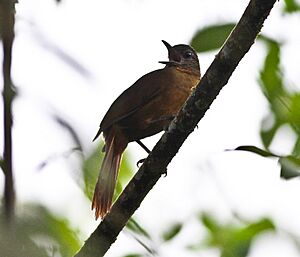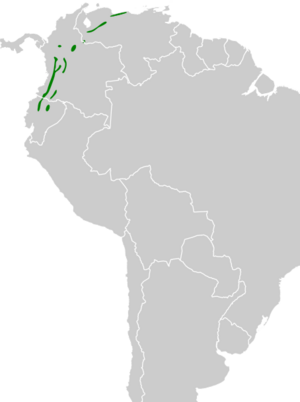Streak-capped treehunter facts for kids
Quick facts for kids Streak-capped treehunter |
|
|---|---|
 |
|
| Conservation status | |
| Scientific classification | |
| Genus: |
Thripadectes
|
| Species: |
virgaticeps
|
 |
|
The streak-capped treehunter (Thripadectes virgaticeps) is a special bird found in the forests of Colombia, Ecuador, and Venezuela. It belongs to the ovenbird family called Furnariidae.
Contents
About the Streak-Capped Treehunter
Different Types of Treehunters
The streak-capped treehunter has six different types, called subspecies. Think of them like different breeds of dogs, but for birds!
- T. v. klagesi (Hellmayr & Seilern, 1912)
- T. v. tachirensis Phelps, WH & Phelps, WH Jr, 1958
- T. v. magdalenae Meyer de Schauensee, 1945
- T. v. sclateri Berlepsch, 1907)
- T. v. virgaticeps Lawrence, 1874
- T. v. sumaco Chapman, 1925
Scientists are still studying these different types to understand them better. Some of them seem to mix together, especially in Colombia and Ecuador.
What They Look Like
The streak-capped treehunter is about 21 to 23 cm (8.3 to 9.1 in) long. That's about the length of a ruler! It weighs around 61 to 65 g (2.2 to 2.3 oz), which is like a small apple. It's one of the bigger birds in its group.
Both male and female birds look very similar. They have a mostly blackish-brown face with light streaks. Their cheeks are a warm, light brown color. The top of their head is blackish-brown with dull spots that turn into streaks.
Their back is a rich dark brown, blending to a reddish-brown on their lower back and tail feathers. Their wings are a reddish-brown, and their tail is a dark chestnut-brown. Their throat is light brown with dark edges on the feathers, making it look streaky. Their belly and chest are a rich reddish-brown.
Their eyes are dark brown, their beak is black, and their legs and feet are greenish-gray to black. Young birds have a throat that is not very streaky.
Differences in Subspecies
- The T. v. sumaco subspecies has streaks on its head that go down to its neck. Its beak is shorter, and its wings and belly are less reddish.
- T. v. sclateri has a more olive-colored back and is lighter on its lower back than the main type.
- T. v. magdalenae has slightly less olive upper parts than sclateri. It also has a shorter beak, less clear throat markings, and brighter, more golden underparts.
- T. v. klagesi has a grayer head with clearer streaks. It has a much shorter beak, a slightly lighter back, and a lighter reddish lower back and tail. Its throat has more blackish markings.
- T. v. tachirensis has a browner back than klagesi. Its lower back and tail feathers are darker and less reddish. Its underparts are darker and more yellowish-brown, and it has a dark shade on its chest.
Where They Live
The streak-capped treehunter lives in different areas that are not connected. This is called a disjunct distribution.
Here's where you can find the different types:
- T. v. klagesi: In the mountains of northern Venezuela.
- T. v. tachirensis: In the Andes mountains of western Venezuela.
- T. v. magdalenae: In the Andes mountains of Colombia.
- T. v. sclateri: In the western Andes mountains of Colombia.
- T. v. virgaticeps: In the Andes mountains of northwestern Ecuador.
- T. v. sumaco: In the eastern Andes mountains of southern Colombia and also in Ecuador.
These birds mostly live in mountain evergreen forests, especially in warmer areas. They also live in forests that have grown back after being cut down. They usually stay hidden in the lower parts of the forest. You can find them at heights from about 1,300 to 2,100 m (4,300 to 6,900 ft) above sea level. In Colombia, they can be found as low as 1,200 m (3,900 ft) and as high as 2,500 m (8,200 ft).
How They Live
Movement
Streak-capped treehunters stay in the same area all year round. They don't migrate.
What They Eat
These birds mainly eat arthropods, like insects and spiders. They might also eat small animals with backbones. They look for food in thick bushes and plants, usually by themselves or in pairs. Sometimes, they join groups of different bird species that are also looking for food. They find their prey by picking and poking along mossy branches and in leaves or other bits caught in the plants.
Reproduction
We don't know everything about when streak-capped treehunters breed, but it seems to happen from at least April to December. They are thought to stay with one partner for life.
They dig a tunnel up to about 1 m (3.3 ft) long in an earthen bank. At the end of the tunnel, they build a cup-shaped nest using small roots. Only one nest has been found with eggs, and it had two eggs. We don't know how long the eggs take to hatch or how long it takes for the young birds to be ready to fly. Both parents help feed the baby birds.
What They Sound Like
The streak-capped treehunter's song is a short series of clear, strong notes, like "chup, cheyp-cheyp-cheyp-cheyp-cheyp." Their call is a fast, sharp "ch-di-dit," "chi-dik," or "ju-dut," repeated every few seconds. They also make a "jwick" sound when they are alarmed.
Their Status
The IUCN (International Union for Conservation of Nature) says the streak-capped treehunter is a species of "Least Concern." This means they are not currently in danger of disappearing. They live in a somewhat small area, and even though we don't know exactly how many there are, their numbers seem to be stable. There are no immediate threats to them. They are considered uncommon to fairly common and live in at least one protected area in both Venezuela and Colombia.


